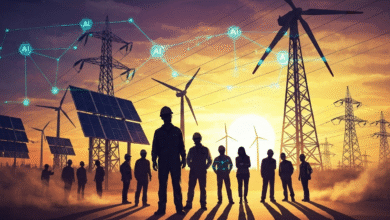AI’s Grid Revolution: Boon or Bane for Our Energy Future?

▼ Summary
– AI can optimize grid operations by solving complex routing problems quickly and reliably, potentially reducing emissions.
– Full AI automation of the grid is still in the research phase, with human oversight remaining crucial during initial deployment.
– AI can accelerate grid planning by speeding up interconnection studies, which currently take months and delay new power plants.
– The lengthy interconnection queue, largely composed of renewable energy projects, could benefit from AI-driven efficiency improvements.
– While AI is not a complete solution for grid planning challenges, it can help expedite processes alongside permitting and other steps.
Imagine a familiar drive to the airport. You know one route that reliably takes about 45 minutes. Another path might save time under perfect conditions, but it’s a gamble on any given day. Right now, our power grid operates much like that cautious driver, choosing the safe, predictable route every time.
That’s where artificial intelligence steps in. According to experts, AI can analyze complex variables in real-time, identifying more efficient pathways for electricity distribution. This isn’t just about saving minutes; it’s about reducing carbon emissions and optimizing energy use on a massive scale. By processing enormous datasets faster than any human team, AI could help grid operators make smarter, cleaner decisions almost instantly.
Still, handing full control to machines remains a distant prospect. Grid infrastructure is simply too critical to risk on unproven automation. Industry leaders emphasize that even as AI tools are integrated, human oversight will remain essential, especially during early implementation phases. Operators need confidence that these systems are both reliable and secure before ceding meaningful control.
Looking further ahead, AI promises to revolutionize how we plan grid expansions. Constructing a new power plant often takes years, bogged down by impact studies and regulatory approvals. These interconnection assessments examine how a new facility might strain existing infrastructure, determining whether costly upgrades will be necessary. Currently, these reports can take months to prepare, creating a bottleneck that delays renewable energy projects.
AI-driven automation could slash that timeline. Some grid operators are already partnering with tech firms to develop tools that generate these reports in a fraction of the time. Speeding up the approval process means clean energy projects can come online faster, helping nations meet climate targets and modernize aging grids.
It’s important to recognize that AI isn’t a magic solution. Regulatory hurdles, permitting, and physical construction will still take time. But by streamlining the planning and analysis phases, AI can help unclog interconnection queues that are packed with solar, wind, and battery projects waiting to connect.
As one industry consultant noted, accelerating these processes is crucial for our energy future. The sooner we can integrate new clean power sources, the more resilient and sustainable our grid becomes. AI offers a powerful toolkit, not to replace human expertise, but to enhance it, helping build an electrical system that’s smarter, greener, and ready for tomorrow’s demands.
(Source: Technology Review)





